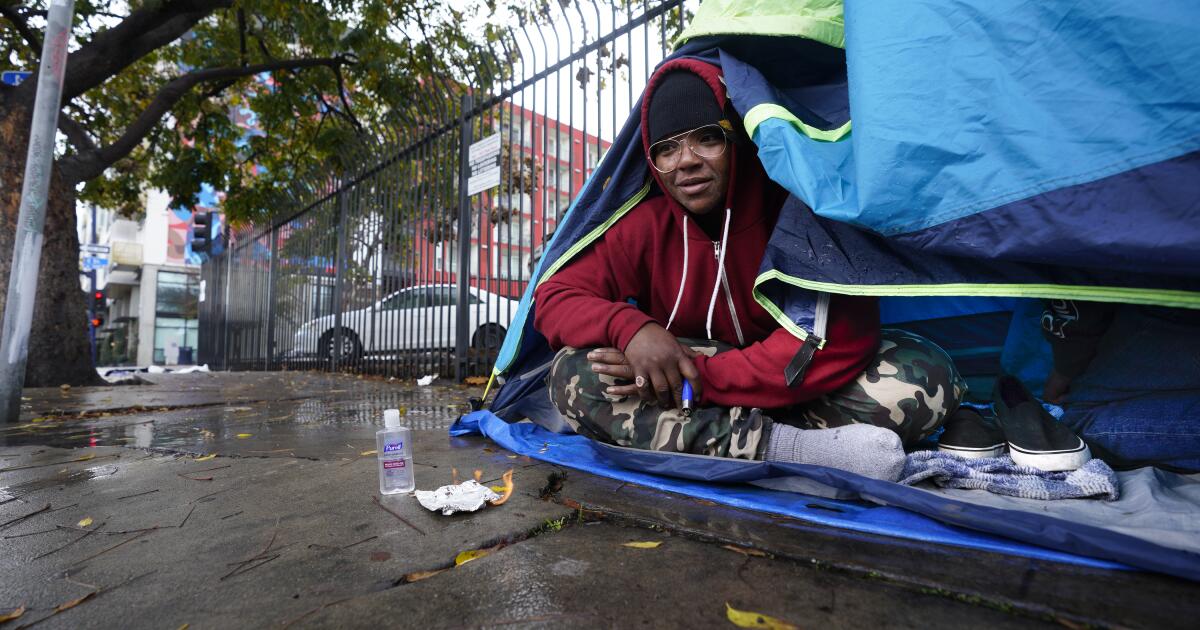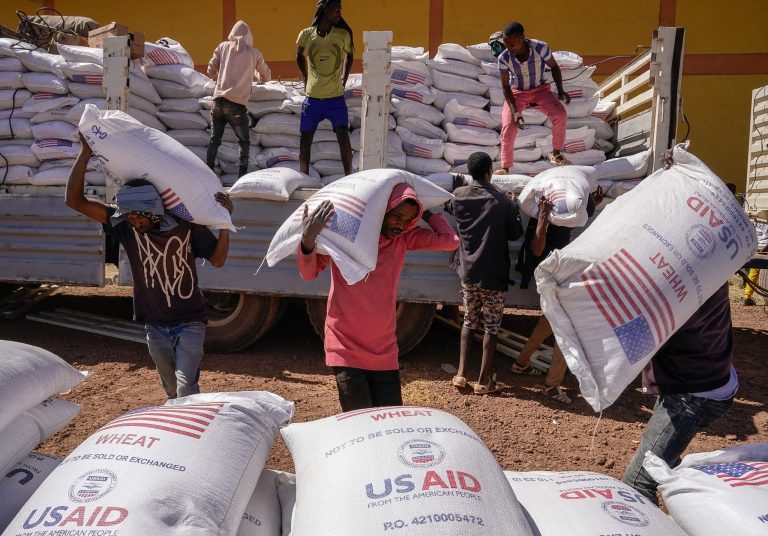
Sometime between sunset Tuesday and Wednesday’s sunrise, the temperature became unbearable.
Brittany McKinney was in a tent downtown. Curling up near a friend wasn’t enough, nor was the body heat from her dog, a young Husky mix.
The 38-year-old placed a square of tin foil on a paper plate and set both on the tent floor. Then she lifted a bottle of Purell, squeezed hand sanitizer onto the foil and flicked a lighter over the pile.
Within moments, the sanitizer ignited.
“I felt a blanket of warmth over me,” she recalled in an interview. “Thank God.”
Dropping temperatures are creating new risks countywide for the thousands of people who sleep outside and putting more pressure on an already strained shelter system. Even though San Diego is warmer than many cities, the area recently hit lows in the 40s and forecasts are warning of nights in the 30s. Plus, wind chill and rain are especially dangerous for those with precarious health.
Over the past 10-plus years, low temperatures have been cited in more death investigations than the heat.
At least 16 homeless people have died throughout the region amid exposure to the cold, according to data from the San Diego County medical examiner that stretches from 2012 through late last year.
The weather sometimes appeared to worsen other problems, like alcoholism or heart disease, but at least four cases listed hypothermia as the only killer. That included a 28-year-old woman at a San Diego bus stop in 2018 and a 59-year-old man in Oceanside three years later.
The overall toll is likely higher as a number of cases that didn’t specify temperature nonetheless involved hypothermia during winter months. That list included a 34-year-old pregnant woman who died in early 2019 after suffering in a canyon.
Downtown Wednesday, the rain came in fits and bursts. Rivulets formed on tarps and flowed past trolley tracks. Sometimes water fell even when blue skies were visible just blocks away.

David Marshall, 54, tries to stay warm on the corner of Broadway and Park Boulevard on Wednesday in downtown San Diego. Marshall says he’s been living on the streets for the past six months.
(Nelvin C. Cepeda / The San Diego Union-Tribune)
David Marshall, 54, lay by a Porta Potty on a soggy cushion. He wore an argyle sweater beneath an orange puffer and a black Johnny Cash jacket, while a brown coat on his head kept rain from the eyes. You could see his breath when he talked.
Marshall said a tent had been taken by police and he was now spending many nights awake and walking, both to keep the blood flowing and to look for anything offering warmth.
This is a common complaint. Many homeless people and advocates say city workers throw away personal belongings, while officials argue that they give plenty of warning before cleaning encampments. Regardless, winter gear can also be stolen or lost or swept away in flooding.
While Marshall was talking, a man in a bright reflector vest approached and nodded toward clothes strewn around the sidewalk.
“Is any of this yours?” the man asked.
Marshall said the clothes were his but a pile of wrappers and boxes by a tree weren’t. A small crew in vests and white jump suits soon appeared and began raking up trash.
The rain increased. Marshall decided to risk leaving what he owned and take cover.
He walked under a nearby overhang and found someone to light his cigarillo. Maybe he’d ride the trolley back and forth to San Ysidro. That was a good way to stay dry.

Sean Wagner, 56, and Sabrina, stand in their tent amid a downtown downpour Wednesday. Wagner says he’s signed up for a safe sleeping site and is on the wait list.
(Nelvin C. Cepeda / The San Diego Union-Tribune)
A number of efforts are underway to keep people from freezing, including The Lucky Duck Foundation’s distribution of thousands of coats that double as sleeping bags.
More makeshift solutions can backfire. One woman living outside said she’d once accidentally set her tent on fire with a plate warmer. (The medical examiner data includes at least three cases of people dying directly from encampment fires.)
Even when people hit a breaking point and ask for shelter, they don’t always get a bed. Data shows that the majority of requests to stay at many traditional facilities failed in recent weeks.
One man Wednesday said he did have a spot at an Alpha Project facility but still spent time in a tent to be near his girlfriend. (Shelters often separate men and women.) Another believed he was on a list for a safe sleeping site, one of the legal camping areas by Balboa Park. A woman said she was hesitant to stay in one of those “tent cities” because she worried how her dog would respond to other people’s pets.

Two people and their pet live in a tent by the corner of Broadway and 13th Street in San Diego.
(Nelvin C. Cepeda / The San Diego Union-Tribune)
McKinney, the 38-year-old with the Husky, said she was open to shelter.
“You get so caught up in trying to survive the day that you forget to call the number,” she told a reporter. “Thanks for reminding me.”
Sitting cross legged in the tent, feet covered with thick socks, McKinney demonstrated how she starts fires.
She set some foil outside, near the corner of 13th and E streets, and squeezed an upturned bottle of Purell. Mixing in wax would make it last longer, she said. Stuffing a sanitizer-soaked sponge in a can also helped, but you had to stay awake until everything extinguished. A hole in the floor of her tent was a reminder of what could go wrong.
McKinney flicked a blue lighter. Wind extinguished the spark. She held up a hand for protection and tried again.
For a moment, nothing happened. Then orange flames erupted over the foil, licking the air. The temperature change was immediate. Even the wind seemed to stop.
The fire burned for about a minute. Then it vanished with a twist of smoke and the cold rushed back over the sidewalk.






